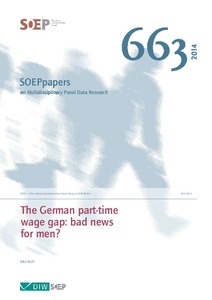The German part-time wage gap: bad news for men
"Despite the increasing incidence of part-time employment in Germany, the effects on wage rates are studied rarely. I therefore use SOEP panel data from 1984 to 2010 and apply different econometric approaches and definitions of part-time work to measure the socalled part-time wage gap of both,...
| Main Author: | |
|---|---|
| Institution: | ETUI-European Trade Union Institute |
| Format: | TEXT |
| Language: | English |
| Published: |
Berlin
2014
DIW |
| Subjects: | |
| Online Access: | https://www.labourline.org/KENTIKA-19118783124919369659-The-German-part-time-wage-gap-.htm |
| Summary: | "Despite the increasing incidence of part-time employment in Germany, the effects on wage rates are studied rarely. I therefore use SOEP panel data from 1984 to 2010 and apply different econometric approaches and definitions of part-time work to measure the socalled part-time wage gap of both, men and women in East and West Germany. A very robust finding is that part-time working men are subject to higher wage penalties than women. Accounting for all available observed as well as time-constant unobserved individual characteristics yields a wage cut of about 10 percent in East and West Germany. Furthermore, the type of contract makes a big difference. While marginal employees earn considerable lower wage rates, irrespective of region and sex, reduced working hours covered with social security do not seem to be to the detriment of women once differences in observed characteristics are taken into account. Fixed-effects panel estimates even yield slightly benefits from working part-time. Nonetheless, long part-time spells may cause financial drawbacks for women, because experience in part-time employment generates lower or even no positive returns. Another novel of my study is the look at the part-time wage gap over the years. The empirical evidence reveals that wage differentials in West-Germany increased over time. Since this trend disappears for men, as soon as individual fixed-effects are disentangled, I suppose that selection of men with progressively unfavourable labour market characteristics triggered this downward slope. In contrast, the downtrend of the female part-time wage gap seems to be caused by the increasing share of marginal employees, who exhibit a significant and larger wage cut compared to standard part-time women." |
|---|---|
| Physical Description: | 33 p. Digital |

